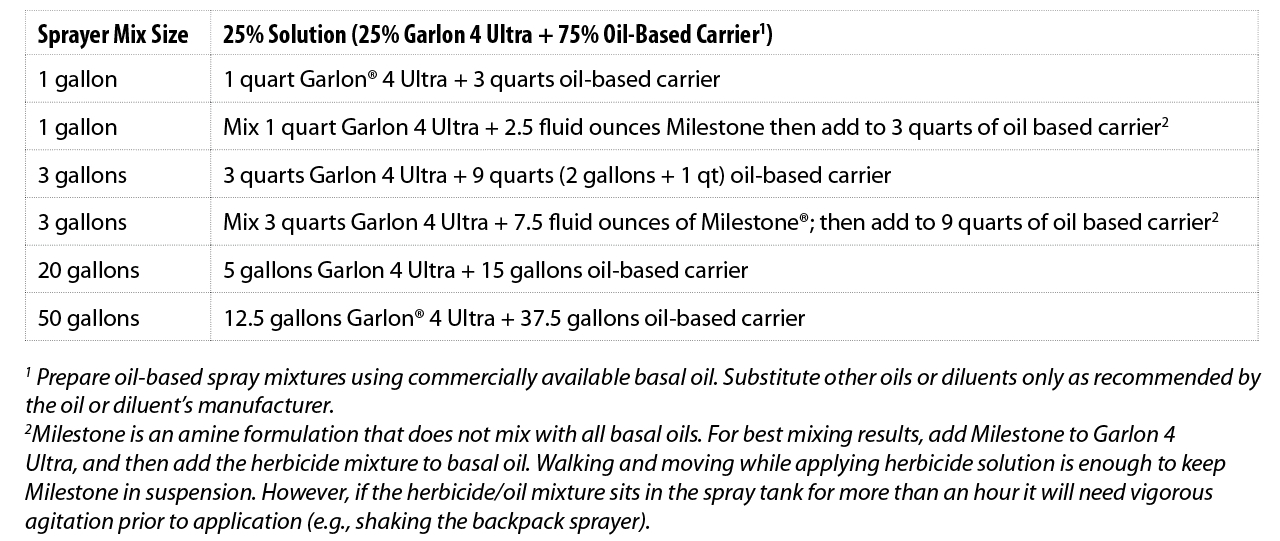Benefits of Basil Applications
Basal treatments on undesirable brush and vines are suited to sites such as fencerows and embankments, bridge ends, urban settings, near desirable vegetation, sensitive areas, and sites with low-density brush and/or vines
Low Volume Basal Treatments
Low Volume Basal (LVB) treatments are well suited for controlling individual woody plants near desirable vegetation or sensitive areas, in low density brush situations, and for trees less than six inches in diameter. Apply the herbicide solution (Table 1) entirely around the circumference of the stem in a band 12 to 15 inches wide, until the stem is thoroughly wet, but not to the point of runoff or puddling (Figure 1).
There are several basal bark oils on the market that work well when mixed with Garlon 4 Ultra. Diesel or kerosene are also commonly used oil-based carriers because they are inexpensive and readily available. Bark Oil Blue LT (LT= low temperature) is recommended when making basal applications at temperatures below 30⁰F since the oil will be stable at lower temperatures when mixed with herbicide. Pathfinder® II is a ready-to-use formulation of Garlon 4 Ultra in a plant-based oil carrier that requires no mixing. However, the herbicide formulation becomes too thick to spray out at temperatures below 30⁰F. See the following tips for successful low volume basal and basal cut stump applications.

Table 1. LOW-VOLUME BASAL and BASAL CUT STUMP tank-mix guide for Garlon® 4 Ultra herbicide alone and in combination with Milestone® herbicide, plus oil-based carrier.

FIGURE 1. LOW VOLUME BASAL BARK (LVB) APPLICATIONS CAN BE USED ON TREES WITH STEMS UP TO BUT NOT GREATER THAN 6 INCHES IN DIAMETER. SPRAY AROUND THE CIRCUMFERENCE OF THE TRUNK AT A HEIGHT OF ABOUT 12 TO 15 INCHES UNTIL WET, ALL THE WAY AROUND THE MAIN STEM TO THE GROUND LINE, BUT NOT TO THE POINT OF RUNOFF OR PUDDLING.
Tips for Successful Low Volume Basal and Basal Cut Stump Applications
Use a sprayer that has a shut off at the spray tip to avoid wasting material.
Sprayer seals, hoses and pumps should be resistant to oil-based carriers.
Use an adjustable cone spray tip, such as Spraying Systems ConeJet 5500-X3 or Y3 up to X8.
Apply herbicide spray to plant stems similar to applying spray paint.
Treat all the way around the plant stem in a band from the soil surface (root collar area) to 12 to 15 inches in height (Figure 1).
Do not treat plant stems that are saturated with water/precipitation.
Basal Cut Stump Treatments
Basal cut stump treatments involve cutting six inches above the ground level followed by an herbicide application (Figure 2, left). Apply the herbicide solution (see Table 1 for a tank-mix guide) to sides of the stump, including the root collar area, and outer portion of the cut surface (cambium) until thoroughly wet but not to the point of runoff. Avoid cutting followed by herbicide application during heavy sap flow since this can interfere with penetration of oil-based basal mixes and decrease control. Heavy sap flow can also carry the herbicide mixture off the stump resulting in poor control. While it is customary to treat soon after cutting, applications may be made any time after cutting (for example, cut in winter and treat the following spring).

FIGURE 2. COMPARISON OF A BASAL CUT STUMP APPLICATION (LEFT) AND CUT STUMP (RIGHT). FOR BASAL CUT STUMP APPLICATIONS, APPLY THE HERBICIDE SOLUTION TO SIDES OF THE STUMP, INCLUDING THE ROOT COLLAR AREA, AND OUTER PORTION OF THE CUT SURFACE (CAMBIUM) UNTIL THOROUGHLY WET BUT NOT TO THE POINT OF RUNOFF. CUT STUMP APPLICATIONS SHOULD BE MADE BY APPLYING THE HERBICIDE IN A CONTINUOUS RING ON THE CUT SURFACE OF THE TREE.
Cut Stump Treatments
Cut stump treatments involve cutting the tree close to the ground and applying undiluted Vastlan® herbicide only to the exposed cambium (Figure 2, right). Cut tree surfaces should be treated immediately (within 30 minutes) with undiluted Vastlan. Cut stump treatments may be made any time of the year as long as the herbicide does not freeze when applied, and the tree is not frozen. Avoid cutting followed by herbicide application during heavy sap flow since this can interfere with translocation. Heavy sap flow can also carry the herbicide mixture off the stump resulting in poor control. Cut stump applications should be made by thoroughly spraying the outer two inches of the cut surface of the tree. Apply undiluted Vastlan in a continuous ring between the bark and the wood of the stump. If the bark is torn away from the stump, be sure to treat down the side to form a continuous ring around the bark since the coverage and uptake is essential for root kill.
Celestine Duncan contributed to this article.
Published: December, 2013; Updated December 2019
®™ Trademarks of Dow AgroSciences, DuPont, or Pioneer and their affiliated companies or respective owners.
Milestone® and Vastlan® herbicides are not registered for sale or use in all states. Contact your state pesticide regulatory agency to determine if a product is registered for sale or use in your state.
Milestone: When treating areas in and around roadside or utility rights-of-way that are or will be grazed, hayed or planted to forage, important label precautions apply regarding harvesting hay from treated sites, using manure from animals grazing on treated areas or rotating the treated area to sensitive crops. See the product label for details.
State restrictions on the sale and use of Garlon® 4 Ultra herbicide apply. Consult the label before purchase or use for full details.
Always read and follow label directions. ©2019 Corteva



